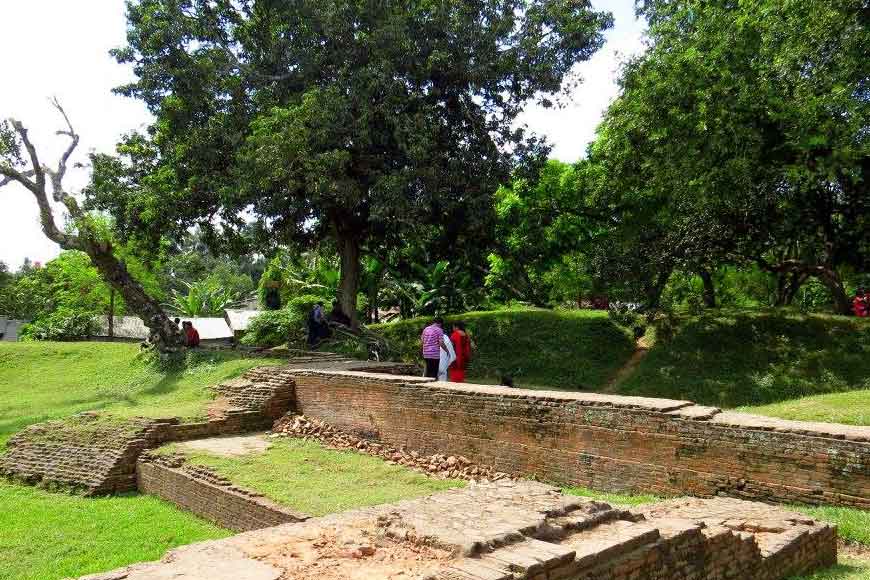Travel with GB to Chandraketugarh

Do you remember Khawnaa’s Bochon? And how her poetic forecasts are still revered? Well, just 40 kms from the city of Kolkata, lies Chandraketugarh – a 2200-year-old pre-Maurya period archaeological site,which boasts of Vikramaditya’s favourite astrologer, Varahamihir’s house. Khawnaawas her daughter-in-law and she used to preach her poetic forecasts from here. Located beside the gorgeous Bidyadhari River,near Barasat, this place is lost in the annals of history.
When we reached there after a dusty village drive, we were already half dusted ourselves.The first impression of the site conveyed an air of utter negligence in terms of maintenance – even the excavations have been left incomplete due to unknown reasons. The site has now become more of a rural romantic getaway for the local couples than a historicsite. Acentury old tree right in the middle of the mounds stands as the only testimony to its rich past.

Finding outsiders taking photographs around the place stimulated interests in various forms to the surrounding public. As we looked around, an old Muslim gentleman left his dirty bicycle near our car and approached us almost voluntarily and introduced us to a neglected chapter of medieval Indian history.
The Chandraketugarh area belonged to a 2500-year old urban civilization,which flourished in the nation during pre-Mauryan period till Pala dynasty. It is often tagged as ‘Mohenjo-Daro of Bengal.’ But due to the sheer disregard from authorities, it never came to the limelight or receive the deserved importance over time.

The brick mounds on which we were standing, belonged to Vikramaditya'sfavour
ite astrologer Varahamihir. His son Mihir was a legendary mathematician of Ancient India, sharing equal credits with Aryabhatta and was one of the esteemed gems of Vikramaditya’s Navaratna jewels.
Upon invitation, Mihir had once been travelling to Ceylon (now Sri Lanka) to exhibit his mathematical skills. There he fell in love with the king’s daughter Lilavati and tied knots with her. After they came back to Chandraketugarh, motivated with the astrological calculations, Lilavati casually started delivering her agricultural predictions to the local women folk.Within a year, her poetic style and accuracy of predictions caught the attention of Vikramaditya and he appointed her as one of his Navaratna gems, replacing her husband Mihir. Thus, arguably she became the first Indian lady to earn a monthly salary.
Varahamihir felt threatened at Lilavati’s rising popularity at the royal court and thus he instigated his son Mihir to take immediate precautions against their capsizing future. Unnerved, he approached the mythical king Chandraketu to seek his guidance. When Lilavati came to know about her husband’s conspiracy, she chopped her tongue off with a double-edgedknife and promised not to talk ever in her lifetime to safeguard Mihir’s honour at the royal court.

This infuriated Vikramaditya and he persistently motivated Lilavati to continue with her tuneful art of predictions. Later, Mihir also realized his offence and requested Lilavati to start prophesying again. It was then she learnt a special art of speaking through her nasal passage. The pronunciation added a nasal tone to her voice and thus with time she came to be more known as Khawnaa (nasal speaker) and her sayings as ‘Khawnaar bachan’.

The brick mounds were the remnants of the temple, prayer hall, adjacent vestibule, astrology chamber, living room, kitchen and remaining portions of the mansion of Khawnaa and Mihir. Now only the wrecked brick walls remain with a green carpet of long grown grass over them at places. But there is an indigenous anticipation that many precious gems of golden age might be hidden inside.

The roof had already collapsed long back, perhaps even before the half-hearted excavations had started. Due to the eroding condition of the structures and brittleness of the primeval bricks, it has been left half dug by the authorities and theedifices are mostly underground at present. There did exist a flight of broken stairs which led us to the lower floors of the building, but due to fears of snakebites, we could not walk to the bottommost level.

The old man also warned us of misleading patch of green grasses over the mounds – It has soft pits at many places and no one knows if you happen to step on any of them, in which obscure world will you end up in! Some ancient Kharosti scriptures were visible on the brick walls of the temple, probably the place from where Khawnaa used to chant her melodicforecasts every afternoon.
The sun had set in the west by then. We thanked the old man for rejuvenating the historicsacrifice ofa talented lady.After listening tothe mythical stories surrounding the place, we felt very uncanny to stay there after sunset. Thus, hurried our way back to car and geared off fa









